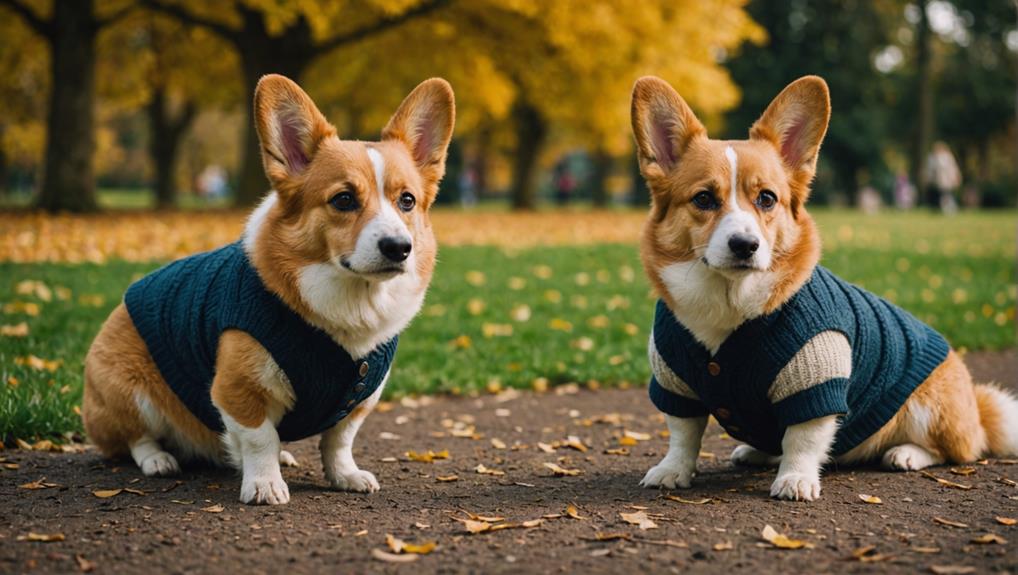When you think about Corgis, it's easy to assume they're all the same, but that's far from the truth. You'll notice distinct differences between the Pembroke and Cardigan breeds, from their physical traits to their temperamental nuances. Understanding these variations can significantly influence your choice if you're considering adding one to your home. Curious about how their historical origins or grooming needs might affect your decision? Let's explore the key differences that set these two charming breeds apart.
Key Takeaways
- Pembroke Corgis are smaller, typically weighing 25-30 pounds, while Cardigans are larger, ranging from 30-38 pounds.
- Pembrokes have shorter, erect ears, whereas Cardigans possess larger, rounded ears.
- Cardigan Corgis have long, bushy tails; Pembrokes often have docked tails or shorter ones.
- Pembrokes are outgoing and playful, while Cardigans are loyal but more reserved and independent.
Physical Appearance

When you first encounter a Corgi, their distinct body shape and expressive features immediately capture your attention. Corgis are known for their short legs, sturdy bodies, and elongated torsos, which gives them a unique silhouette. This specific body type contributes to their playful demeanor and energetic movements, making them a joy to watch as they trot about.
As you examine a Corgi, you'll notice their facial features are equally captivating. Their large, round eyes radiate intelligence and curiosity, while their ears—often upright—add to their alert expression. The combination of a broad forehead and a well-defined muzzle enhances their overall charm, making it hard to resist their playful antics.
Different Corgi breeds may exhibit slight variations in body types and facial features, but they all share that adorable, unmistakable look. Whether they're Pembroke or Cardigan, each Corgi has its own personality reflected in its appearance. Recognizing these subtle differences can deepen your appreciation for this energetic breed, allowing you to celebrate the unique attributes that make each Corgi special.
Tail Variations

Corgis showcase fascinating tail variations that reflect the distinct characteristics of their two breeds: the Pembroke and the Cardigan.
When you look closely, you'll notice the Pembroke Corgi typically has a shorter tail or, in many cases, no tail at all due to tail docking, a practice that's rooted in tradition. This breed's tail length gives them a sleek appearance, which some owners find appealing.
On the other hand, the Cardigan Corgi boasts a long, bushy tail, adding to its distinctive charm. Their tails are full and expressive, often wagging enthusiastically when they're happy or excited. This difference in tail length not only sets them apart visually but also contributes to the unique personality traits of each breed.
While tail docking has been a common practice for Pembrokes, it's worth noting that opinions on this practice have shifted. Many now advocate for leaving tails natural, emphasizing a dog's ability to express themselves fully.
Ultimately, whether you prefer the docked look of the Pembroke or the lively tail of the Cardigan, both breeds are sure to capture your heart with their delightful differences.
Ear Shape
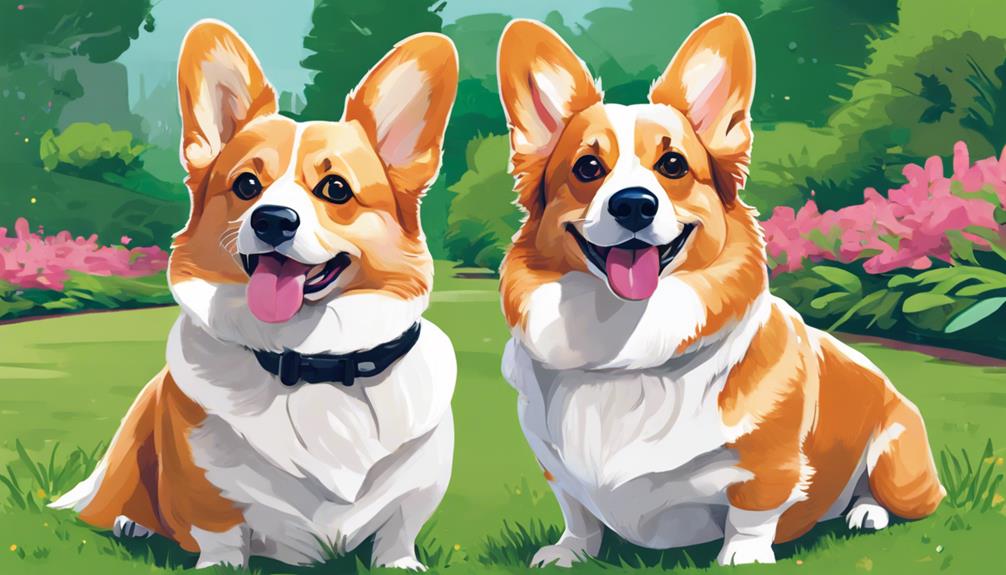
Examining ear shape reveals another striking difference between the Pembroke and Cardigan Corgis that adds to their individual charm.
The Pembroke Corgi typically sports short, erect ears that give it a perky appearance, while the Cardigan Corgi has larger, rounded ears that hang down. This distinction not only contributes to their unique looks but can also impact their ear health.
Erect ears, like those on the Pembroke, allow for better airflow, helping to reduce moisture and wax buildup, which can minimize ear infections. On the other hand, the Cardigan's floppy ears may require more diligent ear care to ensure they remain clean and dry.
Regular checks for dirt and debris are essential for both breeds to maintain optimal ear health. Regardless of the breed, you'll want to establish a routine for ear cleaning.
Use a vet-recommended solution and gently wipe the outer ear with a soft cloth. By understanding these differences in ear shape and their implications for ear health, you can provide better care for your Corgi, enhancing their well-being and happiness.
Temperament Traits
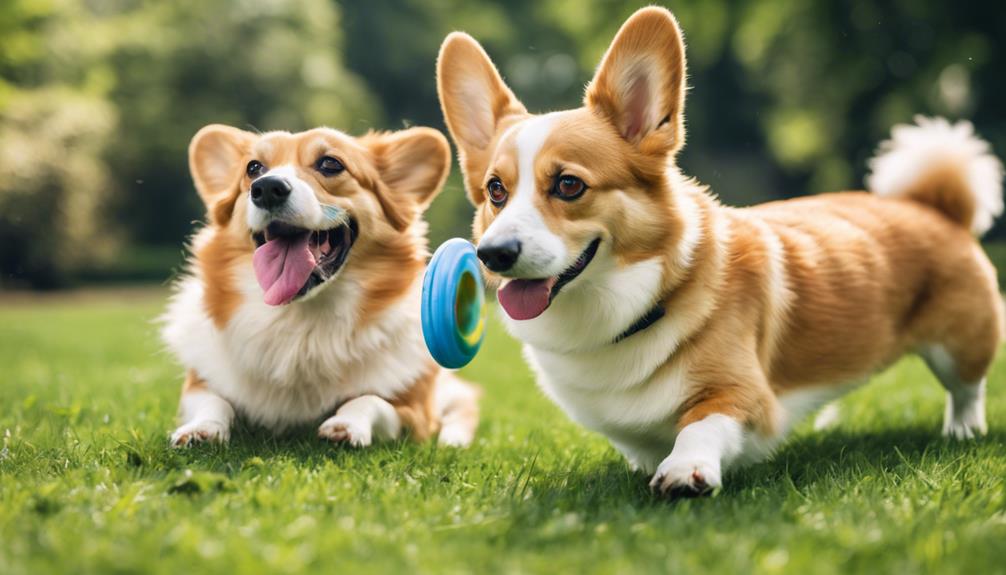
Alongside their distinct ear shapes, the temperament traits of Pembroke and Cardigan Corgis showcase their unique personalities and behaviors that make each breed special.
Pembroke Corgis tend to be more outgoing and playful, often displaying lively social behaviors. They thrive on interaction with people and other pets, making them great companions for families. You'll likely find them eager to engage in playtime or join you on adventures.
On the other hand, Cardigan Corgis are known for their loyalty and protective instincts. They can be a bit more reserved, but once they trust you, their affection runs deep. Their social behaviors might be more selective, which can make them excellent watchdogs.
In terms of training responsiveness, both breeds are intelligent and eager to please, but their approaches differ. Pembrokes often respond quickly to training due to their enthusiastic nature. Cardigans, while also trainable, may require a bit more patience and consistency, as they can be more independent-minded.
Understanding these temperament traits will help you choose the right Corgi for your lifestyle and ensure a harmonious relationship with your furry friend.
Historical Origins
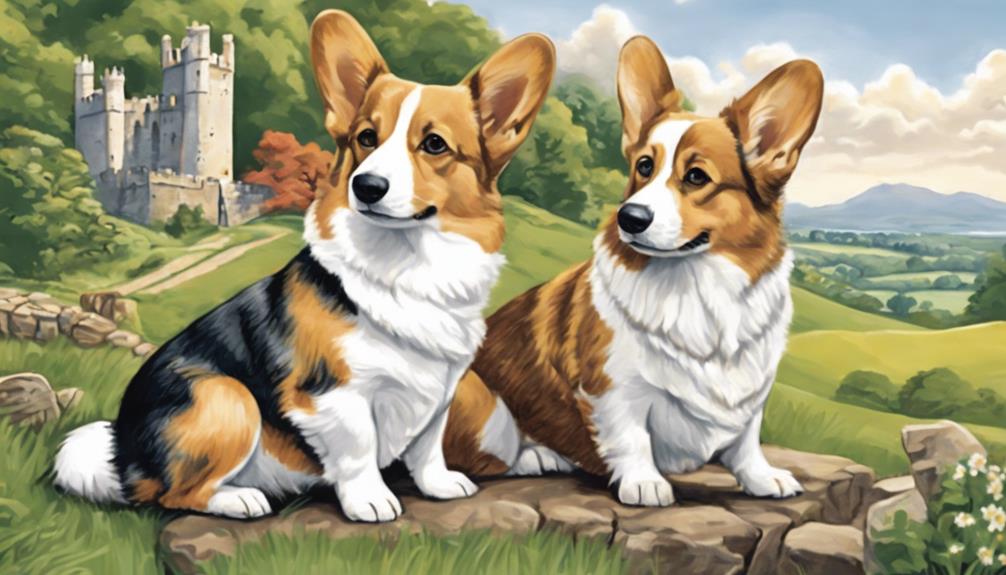
Tracing their roots back to Wales, both Pembroke and Cardigan Corgis have a rich history that reflects their unique development as distinct breeds.
The Cardigan Corgi, believed to have arrived in Wales over a thousand years ago, has connections to the Celts and was often linked to Welsh folklore, featuring in tales of fairies and enchanted creatures. This breed served as a loyal herding dog, adept at managing livestock on the rugged Welsh terrain.
On the other hand, the Pembroke Corgi's origins are tied to the influx of Flemish weavers in the 10th century. These charming dogs quickly gained popularity among the Welsh nobility, leading to their royal connections, particularly with Queen Elizabeth II, who owned several Pembrokes. This royal endorsement helped cement their status as beloved companions and symbols of nobility.
Both breeds embody the spirit of Wales, showcasing a blend of practicality and charm. As you explore their history, you'll find that the stories and legends surrounding Corgis add depth to their character, making them not just pets, but a piece of Welsh culture and heritage.
Size Differences
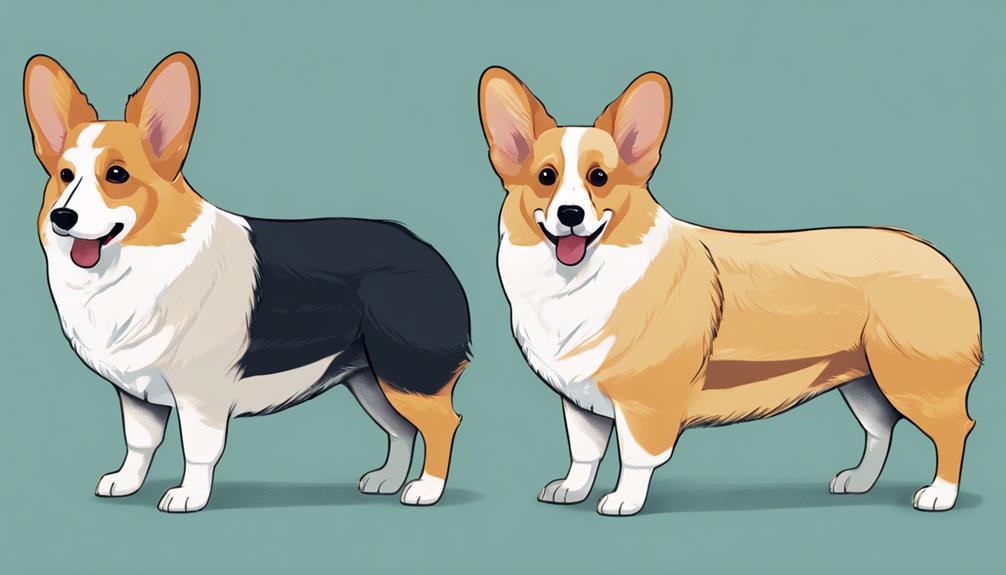
When you look at Corgis, you'll notice distinct size differences between the Pembroke and Cardigan breeds, which can affect their suitability for various living situations.
The Pembroke Corgi typically stands around 10 to 12 inches tall at the shoulder, while the Cardigan tends to be slightly taller, measuring about 10.5 to 12.5 inches. These height variations might seem minor, but they can influence how well a Corgi adapts to your home.
In terms of weight differences, Pembrokes usually weigh between 25 to 30 pounds, whereas Cardigans are a bit heftier, ranging from 30 to 38 pounds. If you're considering getting a Corgi, think about your living space and lifestyle. A smaller Pembroke might be a better fit for an apartment, while a Cardigan could thrive in a house with a yard.
Both breeds are charming and affectionate, but their size differences can impact their energy levels and exercise needs. By understanding these distinctions, you can choose the Corgi that best complements your lifestyle and living situation, ensuring a happy and harmonious home for both of you.
Coat Colors
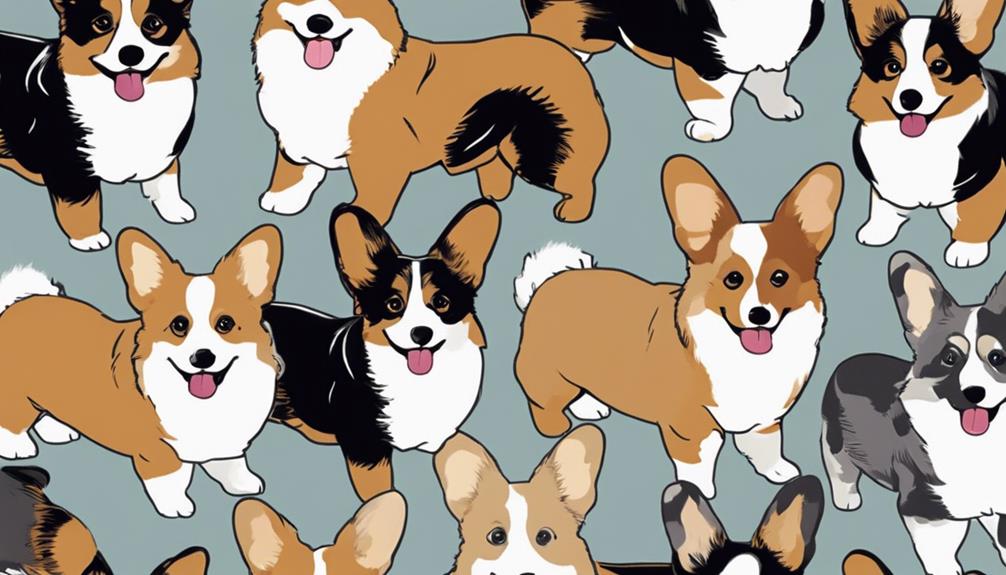
When it comes to coat colors, Pembroke and Cardigan Corgis offer distinct differences that can catch your eye.
While Pembrokes often sport a variety of red, sable, and tricolor patterns, Cardigans showcase a wider range of colors, including brindle and blue merle.
You might also be surprised by some rare coat variations that pop up in these breeds, adding to their unique charm.
Pembroke Vs. Cardigan Colors
The coat colors of Pembroke and Cardigan Corgis showcase distinct differences that can help you identify each breed at a glance. Understanding these variations not only enhances your appreciation for these breeds but also aligns with breed standards established by major kennel clubs.
Pembroke Corgis typically sport a vibrant, shorter coat with colors like red, sable, and fawn, often with white markings. Their color genetics lean towards the dominant red, which is why you'll frequently spot them in these hues.
On the other hand, Cardigan Corgis present a broader palette that includes brindle, blue merle, and red, often with unique white patches. Their genetic background allows for a wider range of colors, making them stand out even more.
Both breeds feature double coats, but the texture and length may vary slightly. While Pembrokes have a softer, shorter coat, Cardigans tend to have a coarser, longer fur.
Rare Coat Variations
Exploring rare coat variations in Corgis reveals some stunning and unique colors that can truly set these adorable pups apart. While many people recognize the classic fawn, black, and tan colors, there are also some uncommon patterns that make certain Corgis truly eye-catching. You might come across a Corgi with a blue merle coat, which features a marbled effect with shades of gray and black. This striking pattern is quite rare and often leaves a lasting impression.
Genetic factors play a significant role in determining these rare coat variations. Breeders who specialize in Corgis often focus on specific genes to produce these unique colors. For instance, the dilute gene can lead to lighter shades and unique combinations that you mightn't see in more traditional colors.
Additionally, some Corgis may exhibit brindle patterns, showcasing a mix of dark and light stripes. These variations not only add to the visual appeal but also reflect the rich genetic diversity within the breed.
If you're on the lookout for a Corgi that stands out, considering these rare coat variations can be an exciting part of your journey!
Exercise Needs

When it comes to Corgis, understanding their exercise needs is crucial for their health and happiness.
You'll find that these playful pups have specific daily activity requirements, unique playtime preferences, and varying exercise intensity levels.
Let's explore how to keep your Corgi active and engaged!
Daily Activity Requirements
To keep your Corgi happy and healthy, you'll need to provide them with plenty of daily exercise tailored to their unique energy levels. Both the Pembroke and Cardigan Corgis are known for their spirited nature, so setting up structured daily walks is essential. Aim for at least 30 to 60 minutes of walking each day, adjusting according to your dog's stamina.
In addition to walks, incorporating engaging playtime routines is crucial. Corgis thrive on activities that stimulate their minds and bodies. Consider games of fetch or tug-of-war, which can be fantastic for burning off excess energy. If you have the space, a securely fenced yard is an excellent option for letting your Corgi romp and explore without restraint.
Keep in mind that Corgis are intelligent dogs; they enjoy challenges. Mixing in some training sessions during playtime can be a great way to keep them mentally engaged.
Playtime Preferences
Corgis have their own unique playtime preferences that reflect their energetic and intelligent nature, making it vital to choose activities that keep them engaged and entertained.
These little bundles of joy thrive on interactive play that stimulates their minds and bodies. You'll find that fetch games are a favorite, allowing your Corgi to unleash their playful spirit while getting a good workout. Just grab a ball or a frisbee, and watch them dart after it with enthusiasm!
Tug toys are another excellent choice, providing a great way to bond while satisfying their instinctive urge to tug and pull. Not only do these toys challenge their strength, but they also encourage healthy competition between you and your furry friend.
Mixing up their playtime routine can prevent boredom, so consider incorporating puzzle toys or agility exercises to keep things fresh.
Exercise Intensity Levels
Understanding exercise intensity levels is crucial for meeting the unique fitness needs of your Corgi, ensuring they stay healthy and happy. Different Corgi breeds have varying exercise requirements, so it's essential to tailor their exercise routines to match their energy levels and activity preferences.
For instance, Pembroke Welsh Corgis tend to be more energetic and may thrive on high-intensity activities like agility training or long runs. On the other hand, Cardigan Welsh Corgis might enjoy a mix of moderate-intensity walks and playful fetch sessions.
To keep your Corgi engaged, try incorporating a variety of exercise options that suit their intensity levels. You can alternate between brisk walks, playtime in the yard, and interactive games that stimulate their minds.
Monitor your Corgi's reactions during these activities; if they seem fatigued or disinterested, you might need to adjust the intensity. On the flip side, if they're bursting with energy, consider increasing the challenge.
Common Health Issues

Many Corgis face specific health challenges, making it essential for owners to be aware of the common issues that can affect the breed.
One major concern is hip dysplasia, a genetic predisposition that can lead to arthritis and mobility issues. Regular vet check-ups and maintaining a healthy weight can significantly reduce the risk of this condition.
You should also be mindful of intervertebral disc disease (IVDD), which occurs when the discs between the vertebrae degenerate or herniate. Corgis, especially, are prone due to their long backs. Preventive care, like avoiding excessive jumping or rough play, can help protect their spines.
Additionally, eye problems, such as cataracts and progressive retinal atrophy, are prevalent in Corgis. Keep an eye out for changes in their vision and consult your vet if you notice anything unusual.
Grooming Requirements

Regular grooming is essential for keeping your Corgi's coat healthy and free from mats and tangles. These adorable dogs have thick double coats that require consistent care. To maintain that beautiful fur, you'll need some basic grooming tools, like a slicker brush, a comb, and sometimes clippers for those more adventurous trims.
Grooming frequency depends on your Corgi's coat type and shedding patterns. Generally, brushing at least once a week is recommended, but during shedding seasons, you might want to increase that to several times a week. This helps prevent mats and keeps loose hair from cluttering your home.
Don't forget to check their ears and trim their nails regularly too. Ear cleaning can prevent infections, and nail trimming keeps their paws healthy and comfortable. Bathing your Corgi every few months will keep them smelling fresh, but overbathing can strip their natural oils, so find a balance.
Embrace the grooming process as a bonding activity with your furry friend. With regular care, you'll both enjoy a happier, healthier relationship and a stunning Corgi coat that turns heads wherever you go!
Frequently Asked Questions
Are There Significant Personality Differences Between Pembroke and Cardigan Corgis?
Yes, you'll find temperament variations between Pembroke and Cardigan Corgis due to their distinct breed histories. Pembrokes tend to be more outgoing, while Cardigans often display a reserved nature, reflecting their unique backgrounds and experiences.
How Do Corgis Interact With Other Pets and Animals?
When you introduce your Corgi to other pets, their playfulness shines through. Corgis thrive on socialization, often engaging happily with various animals, making them delightful companions in multi-pet households or during outdoor adventures.
What Are the Best Training Methods for Corgi Breeds?
To train your corgi effectively, use positive reinforcement techniques. Reward good behavior with treats and praise during obedience training. This method builds trust and encourages your corgi to learn while enjoying the process.
Do Corgis Adapt Well to Apartment Living?
Corgis can adapt well to apartment living if you provide enough exercise and mental stimulation. They generally have good noise tolerance, making them suitable for smaller spaces, as long as you keep them active and engaged.
What Is the Average Lifespan of Different Corgi Breeds?
The average lifespan of corgis typically ranges from 12 to 15 years. Factors like genetics, health considerations, and lifestyle play crucial roles in determining how long your furry companion will thrive by your side.
Conclusion
In conclusion, whether you're drawn to the outgoing Pembroke or the more reserved Cardigan, understanding their key differences can help you choose the right breed for your lifestyle.
From physical traits like ear shape and tail length to temperament and exercise needs, each corgi has its unique charm.
By knowing what to expect, you can ensure a happy, fulfilling companionship with your chosen corgi, making the most of their delightful personalities and quirks.

